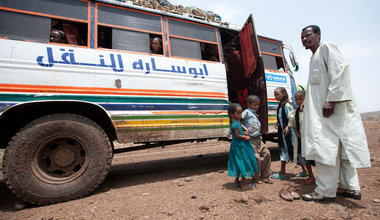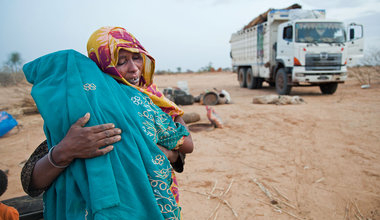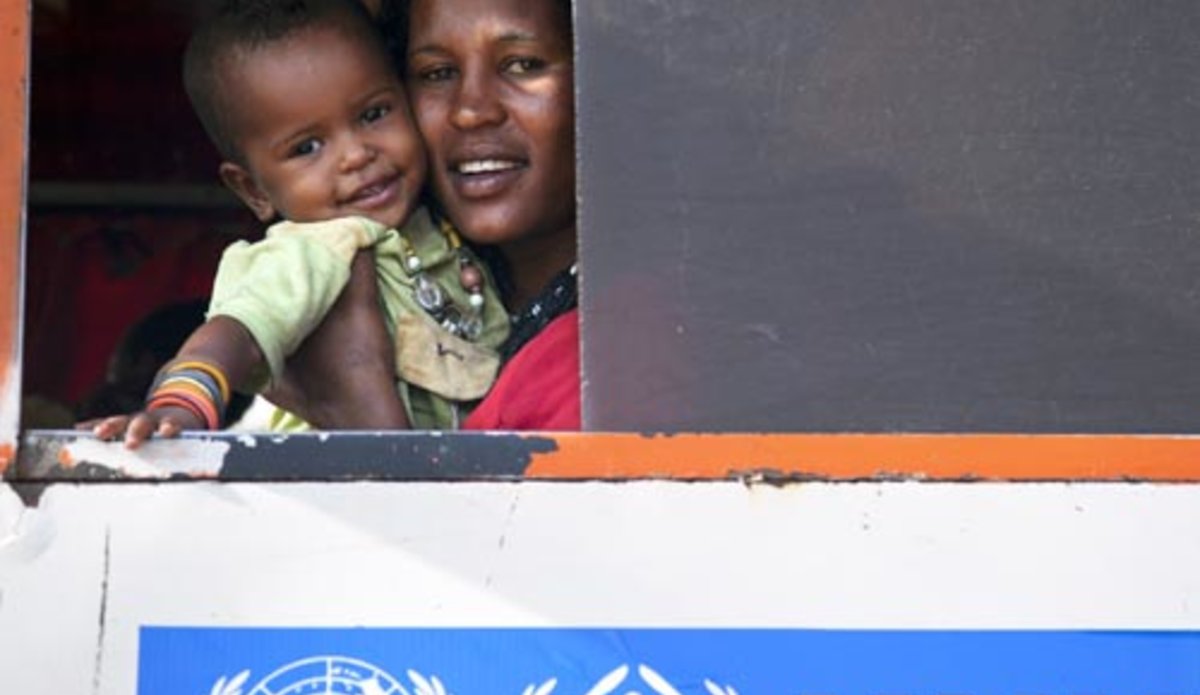North Darfur returnees hope for a life of peace and security
Speaking tearfully, she expressed happiness to be going back home, to join the rest of her family and friends who had left before her. “I want to build a home for my family and cultivate our land that we left,” she said.
Most of the people like Aradia Adam say they decided to go home after learning that their original village was actually rather peaceful and calm.
For many like Aradia, it is a journey of hope, to begin returning home, rebuilding where they left off more than seven years ago.
The UN Refugee agency (UNHCR) and other agencies were requested by the Sudan Humanitarian Aid Commission to assist with the return and reintegration of 230 semi nomadic IDP families from Aramba of Kabkabiya to Sehjanna village, 15-kms North West of Kutum in North Darfur. The five-day returnee operation was supported by UNHCR, the HAC, and other UN agencies. UNAMID provided security and escort along the return route as well water and medical services.
“This is one of the first (IDP) return operations conducted in North Darfur to be led by UNHCR,” said Simon Peter Onyango, Associate Field Officer. UNHCR’s protection cluster took over the mantle of returns in April this year. UNHCR is also conducting returnee exercises in West Darfur, he added. 
Travelling north for more than 95 kilometers, the first group people composed of more than 180 individuals arrived Sehjanna village near Kutum town after a 12-hour journey in trucks and buses. The convoy accompanied by UNAMID military and police drove through narrow, rocky and muddy roads, crossing through valleys before approaching Merla about 54 kilometers from Aramba village where second UNAMID escort took over until the final destination of Sehjanna village, another 62 kilometers distance. Their animals, numbering several thousand, will travel by foot with young herders, a trip that could take three days.
Major Elly Kara, UNAMID military operations officer in Kabkabiya, emphasized that one of UNAMID’s responsibilities is to work closely with UN agencies to facilitate their work and ensure the full protection of civilians in the region.
More than 800 individuals have expressed interest to return to their original homes in Sehjanna, a wide area full of trees. The Sehjanna area includes Damrad Al-Sheikh to the west, Bor Sayed to the south, Fulu to the east and Bowa Termez to the north.
Ahmed Ibrahim Dwelbalt, representative of Humanitarian Aid Commission (HAC) said more than 1,000 families came to Aramba village in 2003. The HAC has been working with UN agencies and non-governmental organizations as well as UNAMID to provide basic needs such as education, health centres and water for the displaced population. A clinic was established and operated by UNICEF and Sudan Red Crescent. The World Food Programme will provide four months of supplementary food for all returnees. The majority of spontaneous returnees began returning to Sehjanna last year and are scattered around the village, some living along the valley commonly known as ‘wadi’. Fadilla Hamadan El Shiek and fifteen of her family members were among those who arrived back in Sehjanna village last year from Aramba village.
Their original village has a school building with two classrooms and needs rehabilitation. The village is equipped with two water points and a clinic located in Damrad El Sheikh about 2 kilometers away supported by WHO. However, returnees voiced their concerns about the availability of water.
Sheikh Mohammed Ali echoed an urgent need for more water in the region. “The water source is running dry. We have no more water, and sometimes the people have to spend a night at the water point to wait for the water table to rise.”
To address the urgent needs of the population in Sehjanna, UNICEF and its implementing partner have said they will begin digging water wells as well as rehabilitate the existing water points. They will also provide two water bladders as the area currently faces an acute shortage of water. UNAMID was also requested to deliver water to the returnees.
At the start of the conflict in 2003, the population of Sehjanna village left the region for Kabkabiya and other neighboring areas. At the time, Sudan forces occupied the area as one of their defensive positions. As the community began to return, a team from UNAMID Ordnance Disposal Office was deployed in the region to clear any mines or unexploded ordnance that may have been left. UNAMID cleared 621,029 square meters of remnants of war to secure the area for the returnees.
During their stay in Aramba village, Kabkabiya, the residents had maintained a nomadic lifestyle: while half of the population remained in the village, the other half took the livestock to pasture lands and migration routes. One of the key factors that contributed to the Darfur conflict was the competition between pastoralists and farmers over land ownership and water resources. Today the nomadic community living in North Darfur relies mainly on livestock and small scale farming, and also receives much assistance from UN agencies, non-governmental organizations and local government.
Much of North and South Darfur is still experiencing clashes between armed movements which has resulted in masses of people fleeing their villages but there are other parts, where people are heading home, noted Sheikh Mohamed.
As the IDPs returned home, they were welcomed by their families and friends. Fatima Ali Ahmed ran to hug her friend upon arrival. Both women were weeping with joy, glad they had made the long journey back home safe to rebuild their community. Families could not wait to begin work, off loading their belongings from the buses and trucks.

A woman hugs her relatives as she arrives to Sehjanna. Photo by Albert González Farran - UNAMID
UN Agencies and UNAMID will conduct an assessment visit to the area following completion of the return exercise, to assess the needs of the population and determine how best they can further assist the people.
The humanitarian community continues to strive to support the people of Darfur by helping to build a favorable environment and ensure that IDPs living among local communities have access to basic services. Humanitarians provide assistance in IDP camps and to the communities of origin and in urban areas, where there are prospects for durable livelihoods.
“Darfur should not be forgotten,” JSR Gambari stressed. “The world celebrated the independence of South Sudan; we need to celebrate the end of the fighting in Darfur, so the people of Darfur can begin to live normal lives, and these 1.8 million IDPs can safely and voluntarily return to their homes.”
Story by: Sharon Lukunka
See more photos on UNAMID Photo Gallery.
 UN
UN United Nations Peacekeeping
United Nations Peacekeeping






